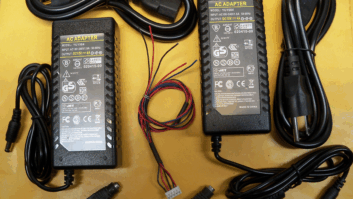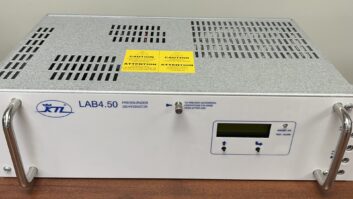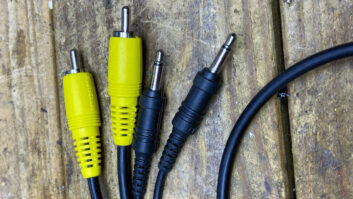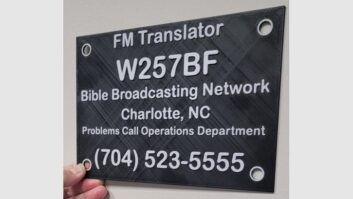I’d like to kick this column off with a heartfelt thank you to all of the Workbench readers and friends who sent congratulatory words on reaching the 30-year Workbench milestone. It’s been great reconnecting with you, and I am truly blessed by each of you. Thanks for your support as we start year 31!
Not all wipes are created equal
One of those messages came from Pennsylvania’s Tim Portzline.
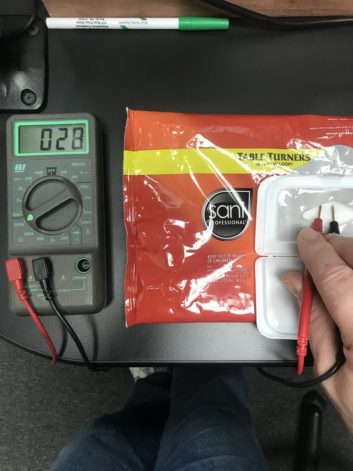
Tim has been reading the column since it first appeared, and he included his first submission with his latest note! He is now an engineer with the Pennsylvania House of Representatives while also doing contract work for several radio stations.
Tim notes that sanitizing wipes are a popular way to clean desks, countertops, doorknobs, etc., especially when trying to stop the spread of COVID-19. However, don’t forget that not all sanitizing wipes are safe for electronics.
He recently got a call from a radio clients about a PR&E BMX console that had failed after being cleaned with wipes that were not intended for use around electronics.
In fairness to the staffer involved, the product labeling didn’t mention anything about sensitive devices. But the liquid in the wipes apparently leaked between the modules and ran down the printed circuit boards below the console’s surface. Channels began turning on and off on their own, and the problem made operating the board impossible for a short time.
By the time Tim arrived at the studio, most of the solution had evaporated so the board was beginning to return to normal. But as a precaution, Tim removed the modules and cleaned them with isopropyl alcohol to eliminate any possible residue that remained.
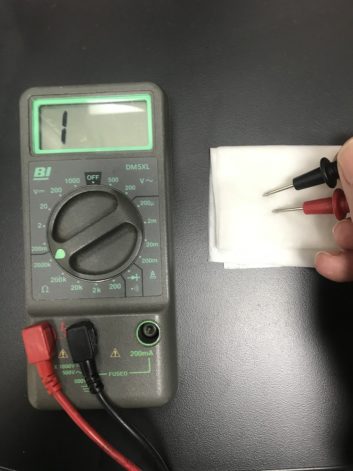
After he finished working on the board, Tim got curious about whether the fluid in the wipes had any measurable resistance.
Ideally, the resistance should have been infinite. However, Tim measured as little as 28K-ohms across a small area with a digital multi-meter, as shown in Fig. 1.
The resistance was certainly low enough to interfere with normal circuit operation of the board, akin to dropping hundreds of stray resistors across the traces of the printed circuit board.
Taking the experiment a step further, Tim tested a paper towel saturated with 91% isopropyl alcohol, shown in Fig. 2.
Here the resistance was infinite, or at least greater than the 2M-ohm maximum resistance of the DMM, making it high enough not to interfere with most low voltage circuits.
So, Tim’s tip: Don’t assume that cleaning wipes are non-conductive! Check them first.
[Related: “Radio Equipment Pandemic Cleaning 101”]
Down the drain
ELWA Ministries Association is a U.S.-based nonprofit, nondenominational Christian ministry providing spiritual and physical aid to the West African country of Liberia.
In addition to a hospital and dental clinic, the organization runs ELWA Radio (Eternal Love Winning Africa), and we welcome their readership.
ELWA engineer Alan Shea writes about condensate drains, which we discussed in Workbench in October. Alan’s tip originates with his dad, who was also a broadcast engineer and was Alan’s first mentor.
To keep the drains clear, especially the trap where water can sit, take a piece of bare #12 solid copper wire and snake it through into the trap where it can sit. The copper leaches out into the trap water and helps kill algae by binding to it, which damages the algae cells, causing them to leak and die.
Another point while we’re on the subject of drains: If you have multiple air handlers, make sure that the condensate drain for each is plumbed individually outdoors, or to a larger drain.
Sometimes, to save time and installation cost, drains are tied together in a manifold-type arrangement. When the tech blows out one drain with compressed air, any algae plugs are simply blown into another A/C unit because of the manifold. Separate drains make more sense.
Alan also had an interesting experience with washing equipment. He encountered a piece of gear with a primary power supply toroid transformer that was a single piece of coiled-up steel. It was running hot, and constantly blowing the input fuse.
Alan realized that the steel laminations had too much eddy currents running through them.
He soaked it in a saltwater solution for an hour, then allowed it to air dry for a day. This created enough rust “insulation” between the laminations to cut down the eddy currents so that the toroid ran cool and no longer blew the input fuse.
Sometimes rust can be a good thing!
Down at the Shack
Any engineers with a little gray on the sides of their heads will remember the ubiquity of RadioShack. I and hundreds of other engineers used their parts more than once, in emergencies, to keep a critical function working.
RadioShack is a shadow of its former self. As a recent AP Business story put it, the company “was unable to capitalize on the PC boom that began in the mid-eighties … it also found itself largely on the outside of the portable device revolution of the aughts and drifting toward irrelevancy. It booked its last profit in 2011.” The brand has been through two bankruptcies in recent years.
Longtime Workbench contributor Dan Slentz dropped us a neat note about an online revival of RadioShack. According to business news reports, the new majority owner Retail Commerce Ventures is a retail acquisition group whose strategy is to buy well-known brands that can benefit from its e-commerce expertise. They previously bought Modell’s Sporting Goods and Pier 1 Imports out of bankruptcy.
The new RadioShack will be online, selling from its own website and via an Amazon storefront. Let us know of any experiences you have with it.
The existing 400 or so brick-and-mortar RadioShacks operate independently and remain open.
What’s hard to believe is that the brand will celebrate its 100th birthday in 2021.
E-commerce sites
Speaking of the internet, Frank Hertel, a consultant with Newman-Kees and another longtime Workbench contributor, was intrigued by the online store Ali Express, which is part of the Alibaba Group based in China that you may have read about. The site is www.aliexpress.com. It offers a most varied selection of “things” — wall-mounted stands, brackets, cables and even gaming accessories.
Have you had experiences good or bad with that e-commerce site or any other alternatives to Amazon, in shopping for things to help you in your engineering work? Drop us a note and let us hear about them.
John Bisset has spent over 50 years in the broadcasting industry. He handles western U.S. radio sales for the Telos Alliance. He holds CPBE certification with the Society of Broadcast Engineers and is a past recipient of the SBE’s Educator of the Year Award. Workbench submissions are encouraged, qualify for SBE recertification and can be emailed to [email protected].

